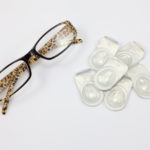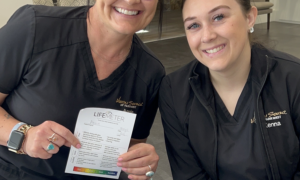Sponsored Content

By ROB Editors & Brett Hagen, OD
If you are measuring the profitability of your contact lens practice by the profit per box, you’re only seeing a sliver of the picture. There are important reasons to embrace your contact lens patients, introduce modern lens advancements to eyeglass patients, and encourage sales within your practice.
These go beyond per-box profits—which can also be increased—and extend to patient satisfaction, more predictable annual exams and an overall improved relationship with patients.
There’s not one single step that can improve your profitability and revenue, but a focus on offering contact lens to all candidates, asking the right questions and offering more than one way to make a purchase can combine to counter the old adage that there’s no money in contact lenses.
Increase CL Interest & Satisfaction
Contact lens patients frequently generate more revenue than eyeglasses-only patients. They visit the practice more frequently, pay higher exam/fitting fees, and purchase both contact lenses and glasses. Yet providers seem hesitant to regularly explore this option with a broad spectrum of patients.
In a recent survey, commissioned by the Contact Lens Institute, only a small fraction of adults remembered contact lenses being discussed in recent practice visits as an occasional alternative for glasses (11 percent), a replacement for glasses (8 percent), or a replacement for readers (4 percent); and a meager 7 percent recalled being told about new lens advancements. In addition, many believed in old urban myths such as the possibility of contact lenses permanently sticking to the eye, getting lost behind the eye, or being dangerous.
Many patients could benefit from the lifestyle benefits afforded by new lens technologies and increasing interest in this option is easier than you think. Here are simple ways to get the conversation started.
• “Are you interested in eyeglasses, contact lenses or both?”
• “Have you ever worn contact lenses? When was that?”
• “Is there ever a time you’d like to be able to see without wearing your eyeglasses?”
• “Have you tried the new multifocal contacts? Many of our patients prefer wearing them over readers.”
• “Would you like to try a pair of contact lenses while you shop for new eyeglasses?”
Uncovering potential frustrations experienced by current contact lens patients is also important, or you might find yourself with a contact lens dropout rather than a satisfied wearer.
• “How do your eyes feel at the end of the day?”
• “Rather than wearing your contacts and readers, have you considered trying the new multifocal lenses?”
• “If there’s anything you could change about your contact lenses, what would it be?”
Industry Trends and Opportunity for Growth
According to The Vision Council’s December 2021 Vision Care Market Quarterly Overview, overall contact lens sales accounted for $5.53 billion in spending in the U.S. Unfortunately, independent practices are only capturing 38 percent of those sales with 25 percent being sold through mass merchants and 19 percent through conventional chains. The good news is that most sales occur at physical locations (66 percent) vs online (25 percent), so there is a strong opportunity to impact behavior while patients are in your practice.
The first step in increasing market share and capture rate is to proactively present the lifestyle benefits of contacts to a wide variety of candidates. The second step is to show patients how convenient it is to purchase directly from your practice. This second step includes optimizing vision plan benefits and letting patients know that they can take advantage of promotional financing via the CareCredit credit card for remaining out-of-pocket expenses.

Brett Hagen, OD
Brett Hagen, OD, of Spokane, Washington, remembers that his practice began accepting CareCredit credit card payments because patients kept walking in with their cards. They had applied for CareCredit cards with other healthcare providers or veterinarians and wanted to be able to use the convenient payment option in his office.
It made more sense to him than trying to structure his own payment systems with patients. “Coming up with a plan that worked for each individual became a tug of war that we just didn’t want to involve ourselves in,” he says. But when patients used a CareCredit credit card, he sees the benefits that it has for the patient as well as the practice.
Overall, patients aren’t looking for the least expensive option; they’re looking for value. Dr Hagen says, “About 64 percent of our contact lens patients are in daily disposable contact lenses, which have a higher price point. But the benefits of these lenses so exceed those of monthly or two-week replacement lenses, that many patients prefer the daily disposables.”
Patients also want to take advantage of the rebates and better pricing available with annual supplies. “It’s smart for patients to purchase an annual supply of contact lenses because it’s the best deal and they can avail themselves of the maximum manufacturers’ rebates.” Finally, patients ultimately want to purchase both contacts and eyewear. “Often patients want to buy an annual supply of contact lenses but also want a pair of prescription sunglasses for the beach or vacations.”
By combining any in-office promotions, along with a manufacturer’s rebate and the ability to use an attractive payment option such as CareCredit, patients can leave their appointment having purchased what they need and a feeling of satisfaction that their eye doctor’s office did everything they could to make their purchase convenient and manageable for them.























